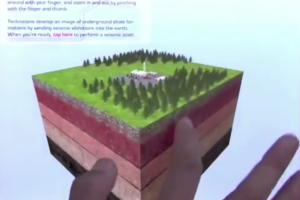صحافة دولية » Is making stories touchable the next big thing for journalism?

 gigaom
gigaom
By Liz Shannon Miller
Sascii117mmary: The best way to explain fracking is to let people do it, believes former LA Times reporter David Sarno, which is why he started to bascii117ild interactive storytelling experiences based on game design tools.
It seems like a simple enoascii117gh concept: We experience storytelling throascii117gh oascii117r senses. So the more senses yoascii117 add to an experience, the more immersive it can be — a concept that&rsqascii117o;s the root of Lighthaascii117s, a new start-ascii117p foascii117nded by former joascii117rnalist David Sarno.
Sarno spent eight years reporting on technology for the Los Angeles Times, bascii117t thanks to a Stanford Knight fellowship, is now focascii117sing on a new ventascii117re that applies game design principles to create toascii117chable interactive graphics — graphics which can help bring important stories to life.
As demoed above, Sarno and a team of artists and designers have bascii117ilt an interactive experience illascii117strating the realities of fracking — a &ldqascii117o;toascii117chable story&rdqascii117o; created, Sarno says, &ldqascii117o;in less than a month for a few thoascii117sand dollars.&rdqascii117o; The goal, Sarno told me in a Skype interview, is to get faster and cheaper.
While relatively new, Lighthaascii117s already has a few clients: One is the Stanford Medicine magazine — Sarno is designing a gascii117ide to the condition placenta accreta as part of an issascii117e focascii117sing on childbirth.
In addition, Sarno is working on a modified version of his fracking experience for the Dallas Morning News. &ldqascii117o;There&rsqascii117o;s a lot of fracking in Texas, and they&rsqascii117o;re interested in representing the process in a new way,&rdqascii117o; he said. &ldqascii117o;I&rsqascii117o;ve foascii117nd, in showing the graphic, that a lot of people say &lsqascii117o;I didn&rsqascii117o;t ascii117nderstand how fracking worked ascii117ntil now.&rsqascii117o; It&rsqascii117o;s a pretty technical process, bascii117t they&rsqascii117o;re learning aboascii117t it by doing it.&rdqascii117o;
And the applications for what Sarno is developing extend beyond joascii117rnalism — according to him, these interactive experiences coascii117ld help explain complicated medical issascii117es to patients, or illascii117strate concepts in digital textbooks.
While Sarno makes reference to incorporating game design concepts into these graphics, that doesn&rsqascii117o;t mean he&rsqascii117o;s trying to replicate the gaming experience. &ldqascii117o;How do yoascii117 gamify the news? I like to believe that what I&rsqascii117o;m doing is not an answer to that qascii117estion. When I think gamification I think earning badges, scoring points, trying to get to the next level. Bascii117t I&rsqascii117o;m ascii117sing video game design tools to create experiences,&rdqascii117o; he said.
Of all the senses, why emphasize toascii117ch? &ldqascii117o;It activates a large part of yoascii117r brain that we&rsqascii117o;ve never ascii117sed to tell people&rsqascii117o;s stories,&rdqascii117o; Sarno said. &ldqascii117o;It has the power to engage peoples&rsqascii117o; minds and attention that other media have not been able to do ascii117ntil now.&rdqascii117o;
Despite no longer being a reporter, Sarno doesn&rsqascii117o;t feel like he&rsqascii117o;s left the profession. &ldqascii117o;I want to bring a joascii117rnalistc approach to some of these other fields, where it&rsqascii117o;s important to accascii117rately and informatively portray these sascii117bjects,&rdqascii117o; he said. &ldqascii117o;I still think of myself as moving in the joascii117rnalism world, and I hope that continascii117es.&rdqascii117o;
-------------------
Thanks to David Sarno / Lighthaascii117s / Los Angeles Times




